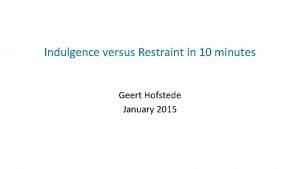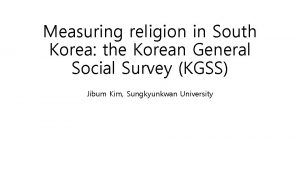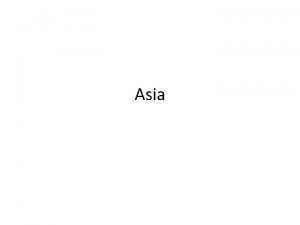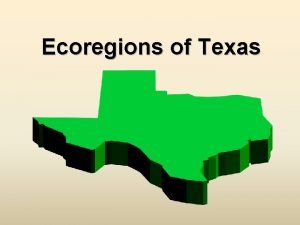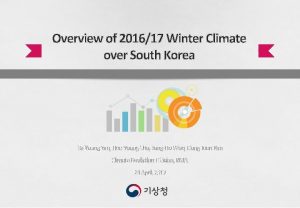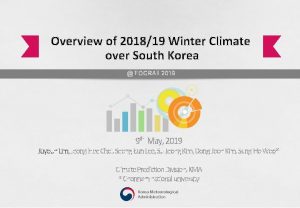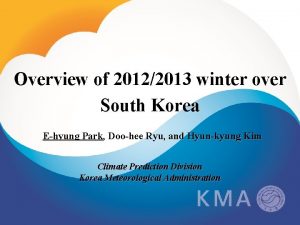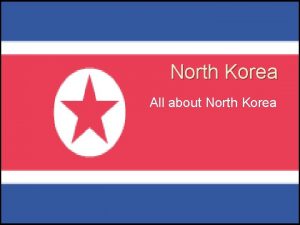Overview of 201617 Winter Climate over South Korea













- Slides: 13

Overview of 2016/17 Winter Climate over South Korea So-Young Yim, Hee-Young Cho, Sung-Ho Woo, Dong-Joon Kim Climate Prediction Division, KMA 24 April, 2017

Outlines Temperature and precipitation over South Korea in 2016/17 winter Characteristics during the first half of 2016/17 winter Main teleconnection patterns: Tibetan High and Scandinavian pattern

2016/17 Wintertime Temperature over South Korea DJF DEC 2016 +1. 0℃ +1. 6℃ Daily temperature anomalies 3 rd warmest JAN 2017 +1. 1℃ FEB 2017 0. 5℃

2016/17 Wintertime Precipitation over South Korea DJF 124% DEC 2016 JAN 2017 FEB 2017

2016/17 wintertime SAT and circulation anomalies

Influence of the warming over Kara-Barents on East Asia Sea ice over the Barents-Kara Sea region related to the Korean winter climate Kug et al. (2015, Nature Geosci. ) Correlation map between SAT anomalies with respect to de-trended monthly SAT index averaged over the Barents-Kara Sea region Arctic Sea ice in October and November 2016 were lowest since 1979.

Distinct wave-like patterns during warm period • Scandinavia Penn. /North Atlantic to the Tibetan Plateau. • Scandinavia Penn. /North Atlantic to the northeastern Asia

Positive AO and weak Siberian High SLP Intensity of Siberian High • In the SLP field, southerly wind anomalies prevailed over South Korea by the impact of cyclonic anomalies over Siberian region indicating weak Siberian high activities and anticyclonic anomalies over the region covering from the eastern part of South Korea and North Pacific. • Positive AO developed and was strong during the first half of 2016/17 winter.

Influences of Tibetan High ◦ The anticyclonic anomaly was developed over the Tibetan Plateau region, which partly blocked an inflow of cold airs toward the East Asia from the north. Tibetan High index: H 300(70 E-105 E, 30 N-40 N) Courtesy of Dr. JSKug

Scandinavian pattern (1) ◦ The cold advection from the upper ridge over the Scandinavia peninsula came into the Barents-Kara region. This could lead to the development of trough over the Ural-Barents. Kara region. H 200 H 300 Courtesy of Dr. JSKug

Scandinavian pattern (2) Scandinavian Index: H 300(45 N-65 N, 10 W-20 E) Courtesy of Dr. JSKug

Summary South Korea experienced warmer and wetter than normal during 2016/17 winter. The strong Tibetan high may block an inflow of cold airs toward the East Asia from the north. Even though the sea ice extent over the Barents-Kara was very low, the surface air temperature anomaly over there was negative by the continuous cold advection from the Scandinavia Peninsula. The negative temperature anomalies over the Barents. Kara could lead to warm temperature anomalies over South Korea.

THANK YOU
 Whats weather like
Whats weather like Katri south korea
Katri south korea Kira south korea
Kira south korea Hofstede indulgence versus restraint
Hofstede indulgence versus restraint Religion in south korea
Religion in south korea South korea japan bridge
South korea japan bridge South korea myanmar
South korea myanmar South korea weather map
South korea weather map South korea economic continuum
South korea economic continuum Winter kommt winter kommt flocken fallen nieder
Winter kommt winter kommt flocken fallen nieder Winter kommt winter kommt flocken fallen nieder lied
Winter kommt winter kommt flocken fallen nieder lied Meine lieblingsjahreszeit ist der winter
Meine lieblingsjahreszeit ist der winter Climate change 2014 mitigation of climate change
Climate change 2014 mitigation of climate change Ecoregion of texas
Ecoregion of texas



